Why you can trust Tom's Hardware
Comparison Products
The 1TB Inland TN436 is up against an array of other 1TB SSDs including the WD Black SN770, the SK hynix Gold P31, the HP FX900, the Inland Prime, the Solidigm P41 Plus, the Samsung 980, and the WD Blue SN570. These drives are all DRAM-less aside from the Gold P31, with the P41 Plus and FX900 being PCIe 4.0.
Trace Testing - 3DMark Storage Benchmark
Built for gamers, 3DMark’s Storage Benchmark focuses on real-world gaming performance. Each round in this benchmark stresses storage based on gaming activities including loading games, saving progress, installing game files and recording gameplay video streams.
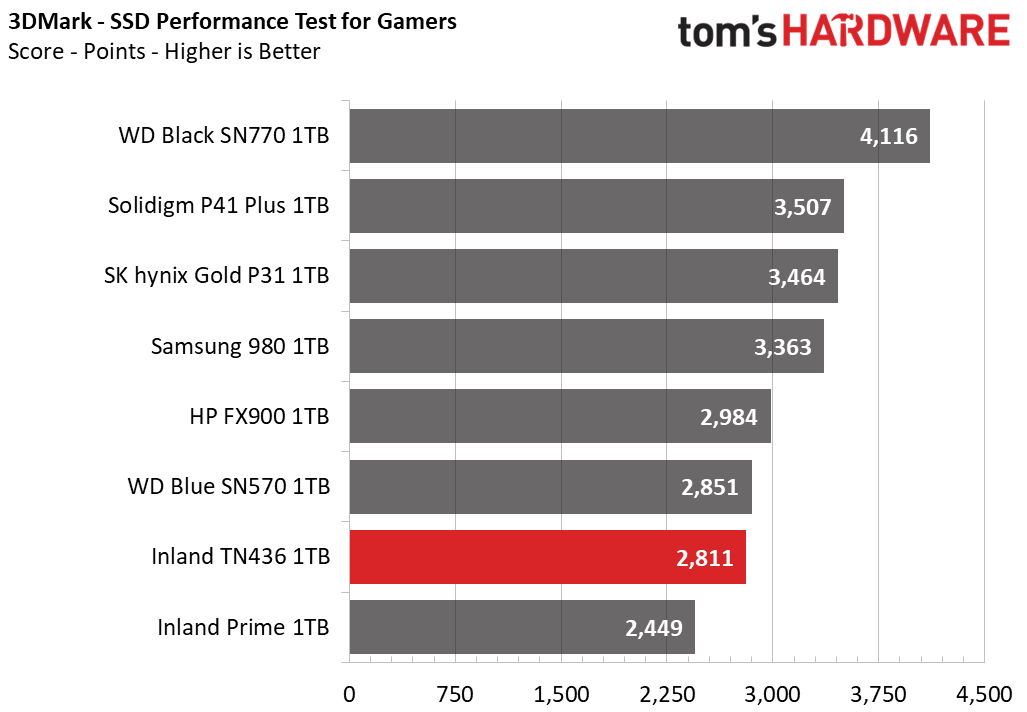
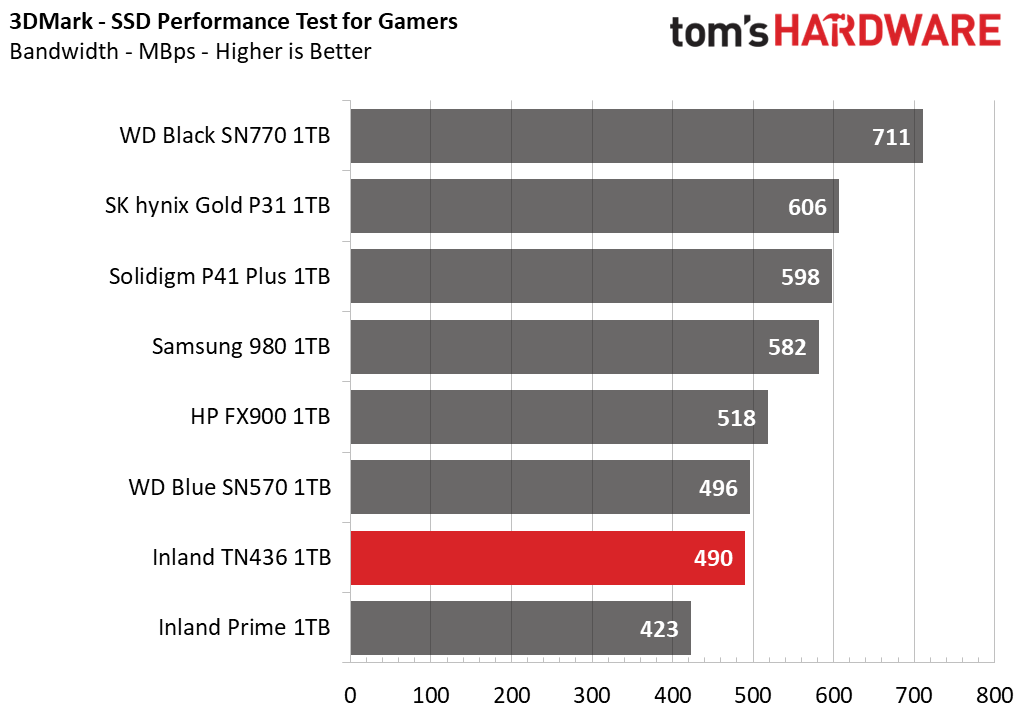

The Inland TN436 comes in second-to-last place, beating only the Inland Prime in 3DMark. The Inland Prime uses a similar controller that’s limited to PCIe 3.0, as mentioned above, but it is paired with different flash. The TN436 can stretch its legs a bit more than to the PCIe 4.0 interface, although it’s basically on par with the Blue SN570.
Trace Testing – PCMark 10 Storage Benchmark
PCMark 10 is a trace-based benchmark that uses a wide-ranging set of real-world traces from popular applications and everyday tasks to measure the performance of storage devices.
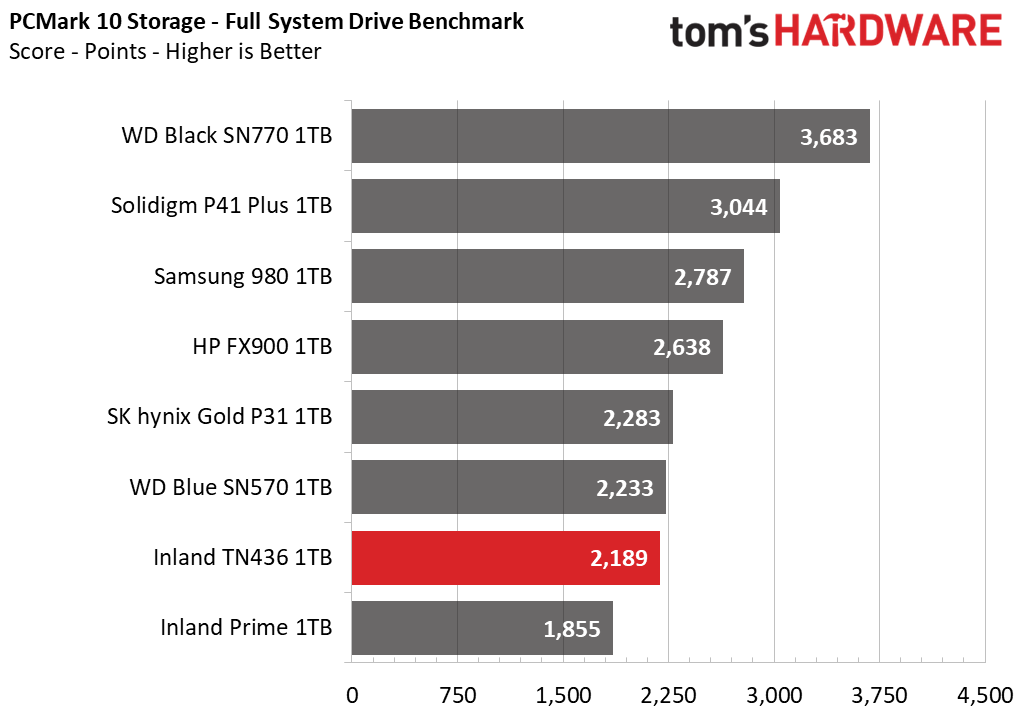
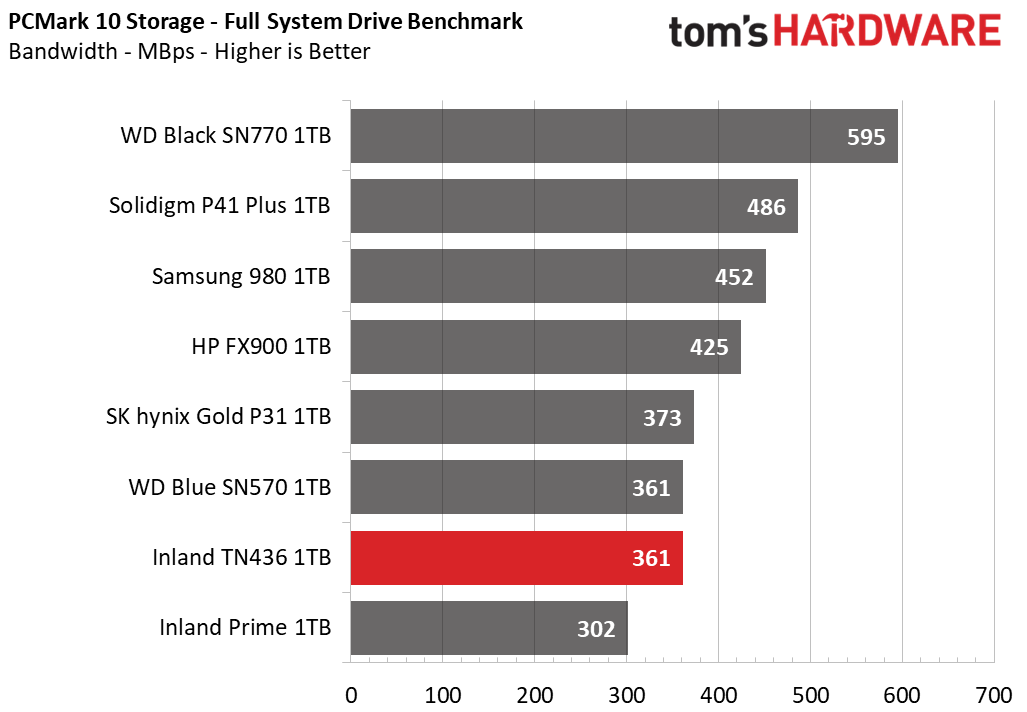
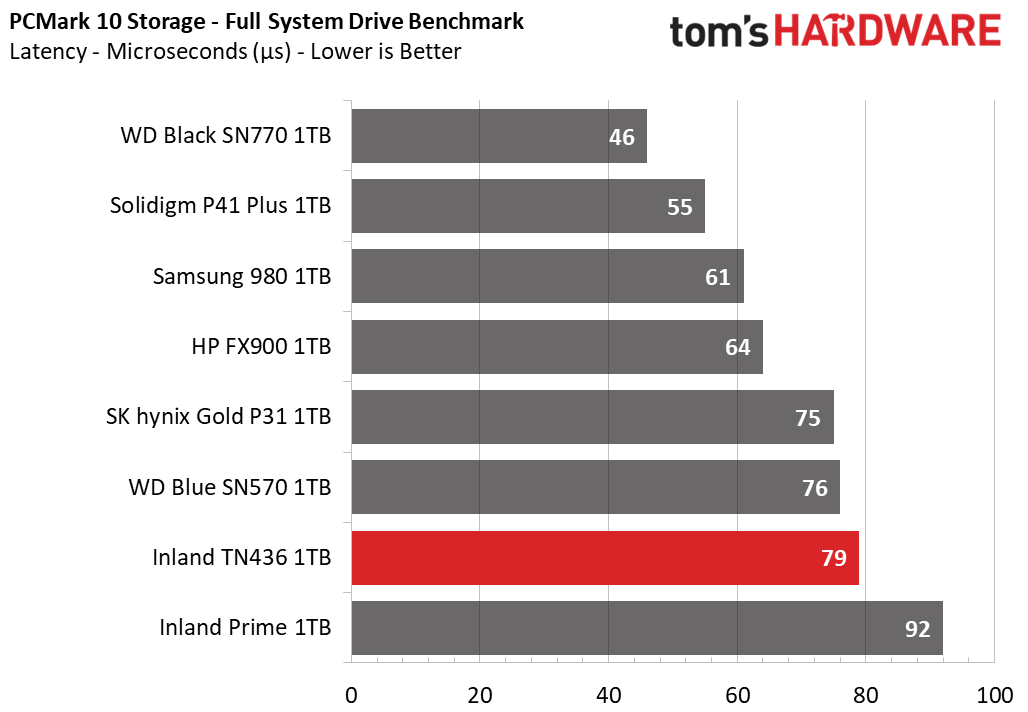
The Inland TN436 once again only beats the Inland Prime, this time in PCMark 10. This is an expected result for these two synthetic benchmarks. It’s worth remembering that this is a 2230 drive that will sometimes be used in less-demanding devices.
Transfer Rates – DiskBench
We use the DiskBench storage benchmarking tool to test file transfer performance with a custom, 50GB dataset. We copy 31,227 files of various types, such as pictures, PDFs and videos to a new folder and then follow-up with a reading test of a newly-written 6.5GB zip file.

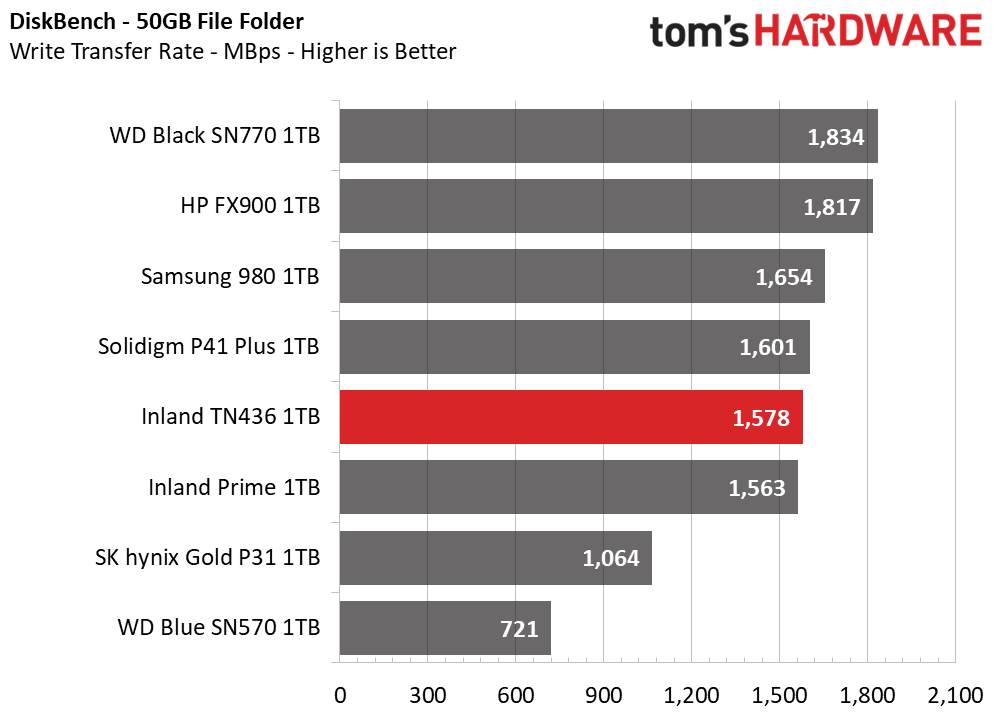

DiskBench reflects bandwidth potential and, as such, the TN436 does better in this test. It is still below average, but bandwidth is often not a big deal for its intended host devices. Valve has in fact used half-bandwidth SSDs on some models and claims there’s no significant impact.
Get Tom's Hardware's best news and in-depth reviews, straight to your inbox.
Synthetic Testing - ATTO and CrystalDiskMark
ATTO and CrystalDiskMark (CDM) are free and easy-to-use storage benchmarking tools that SSD vendors commonly use to assign performance specifications to their products. These tools give us insight into how each device handles different file sizes.

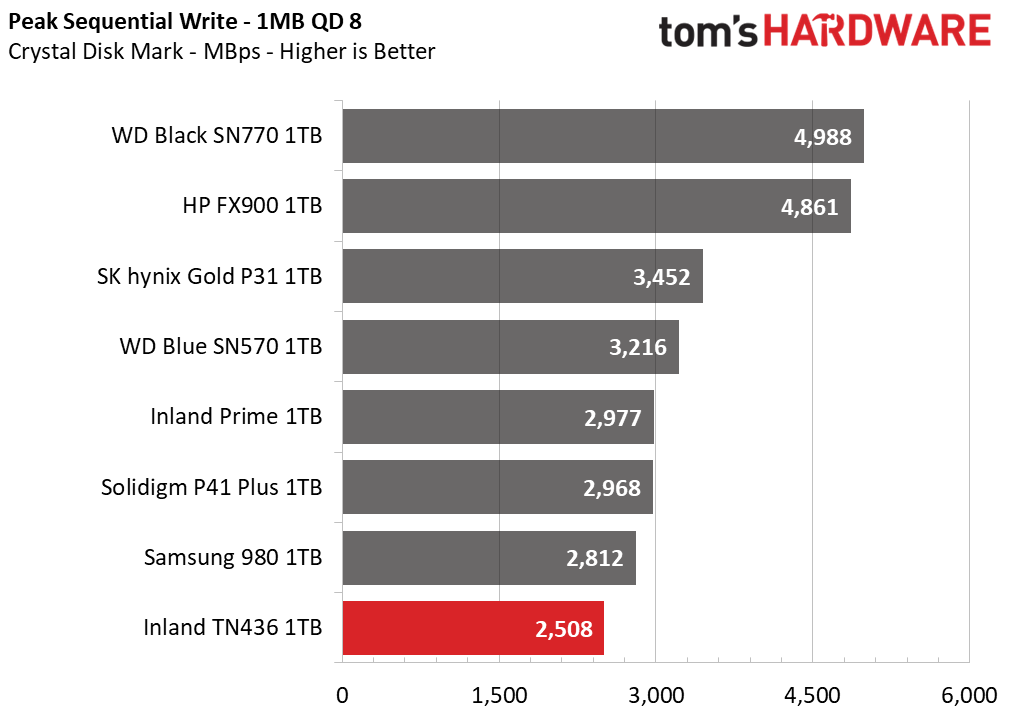


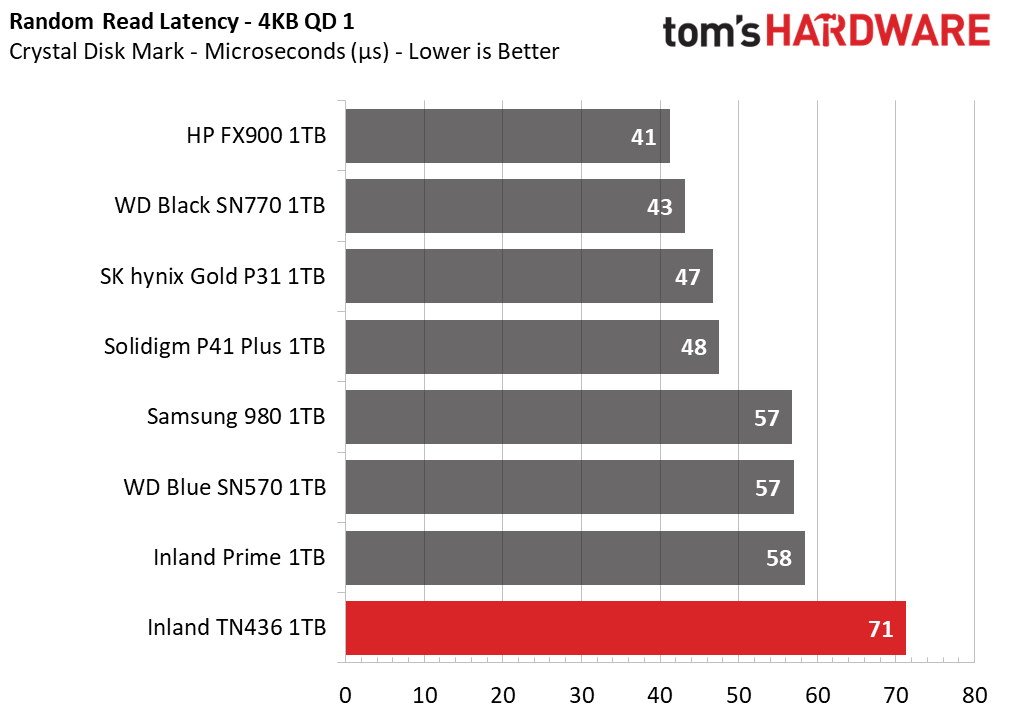
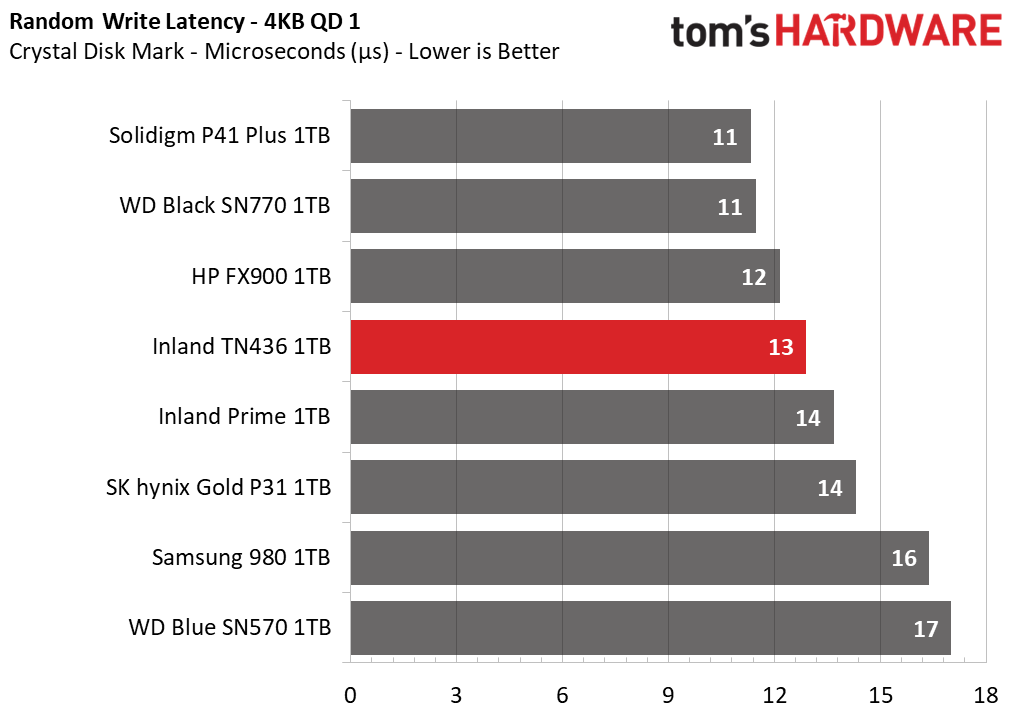
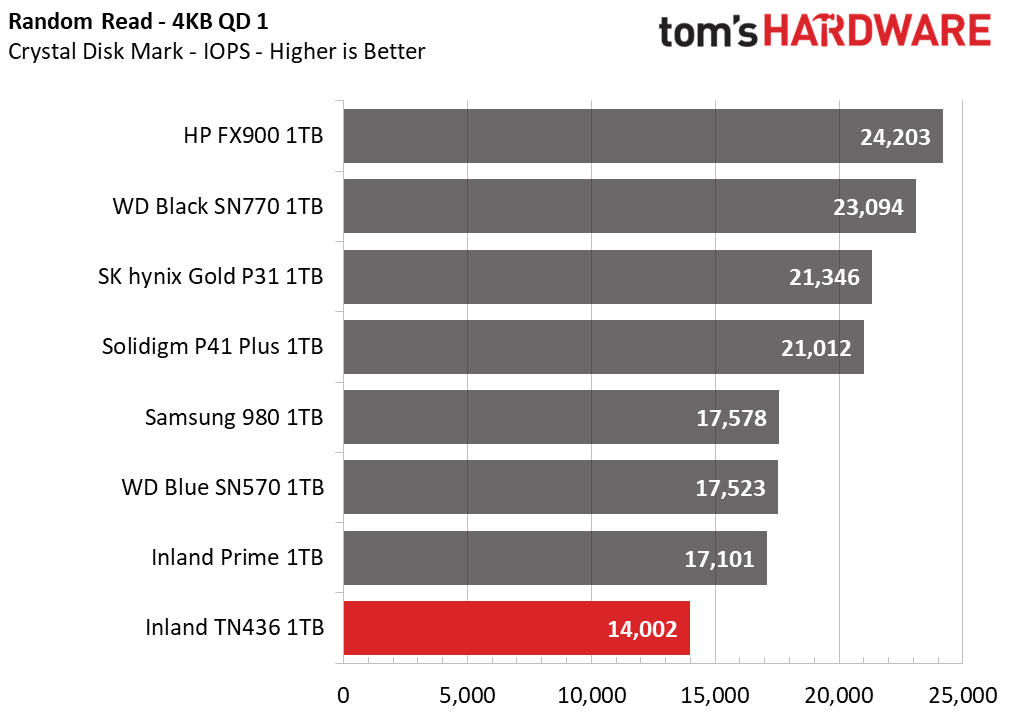
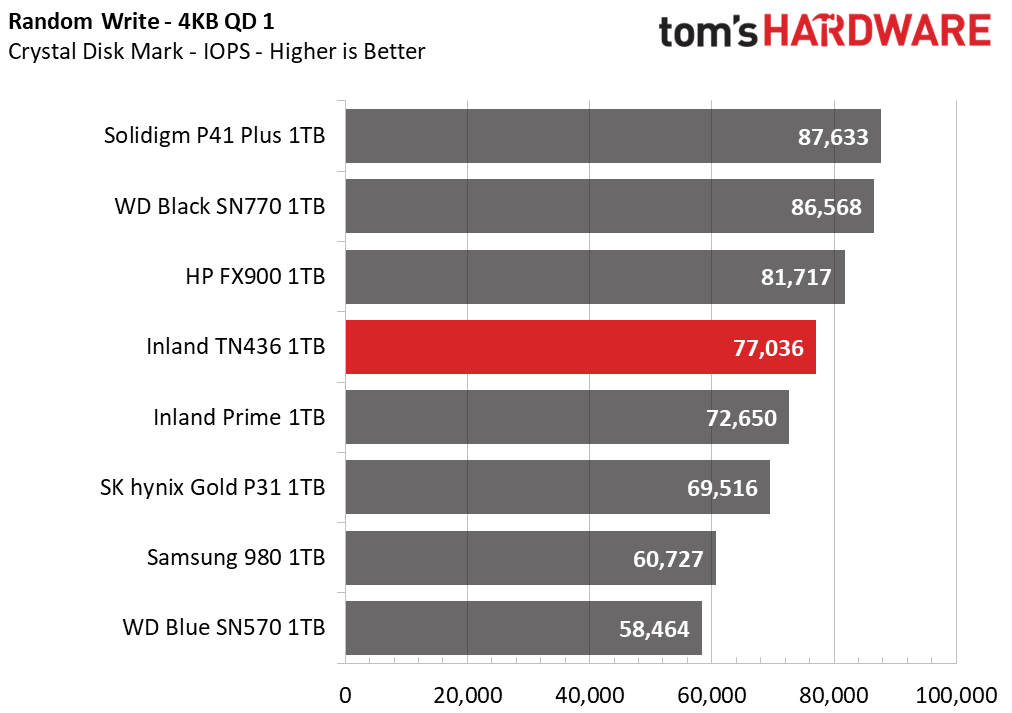
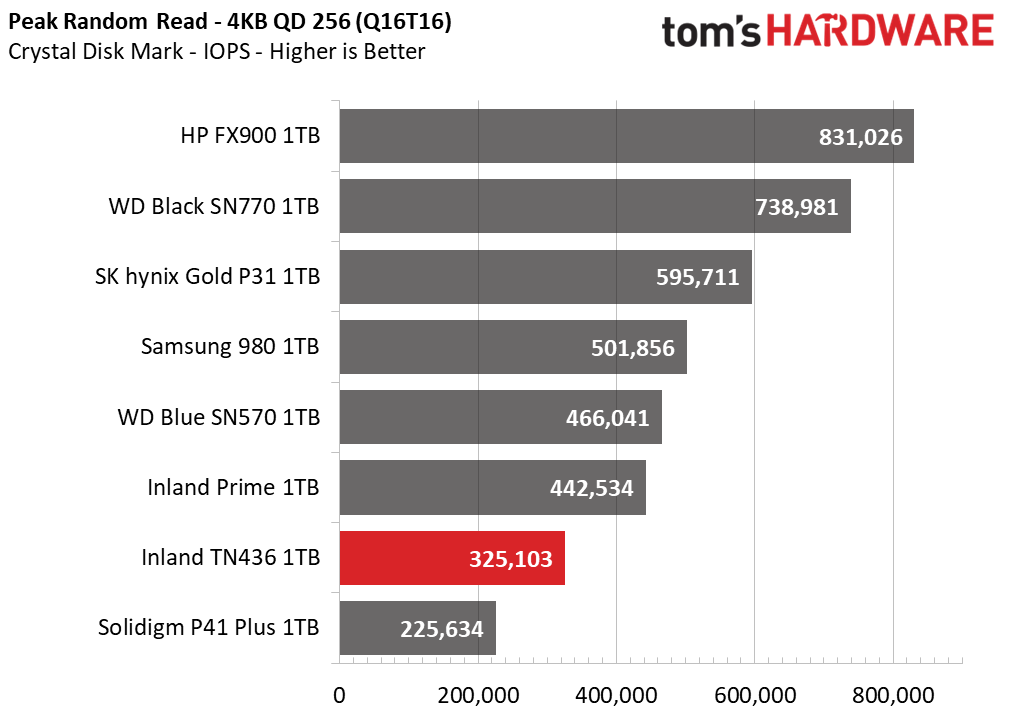
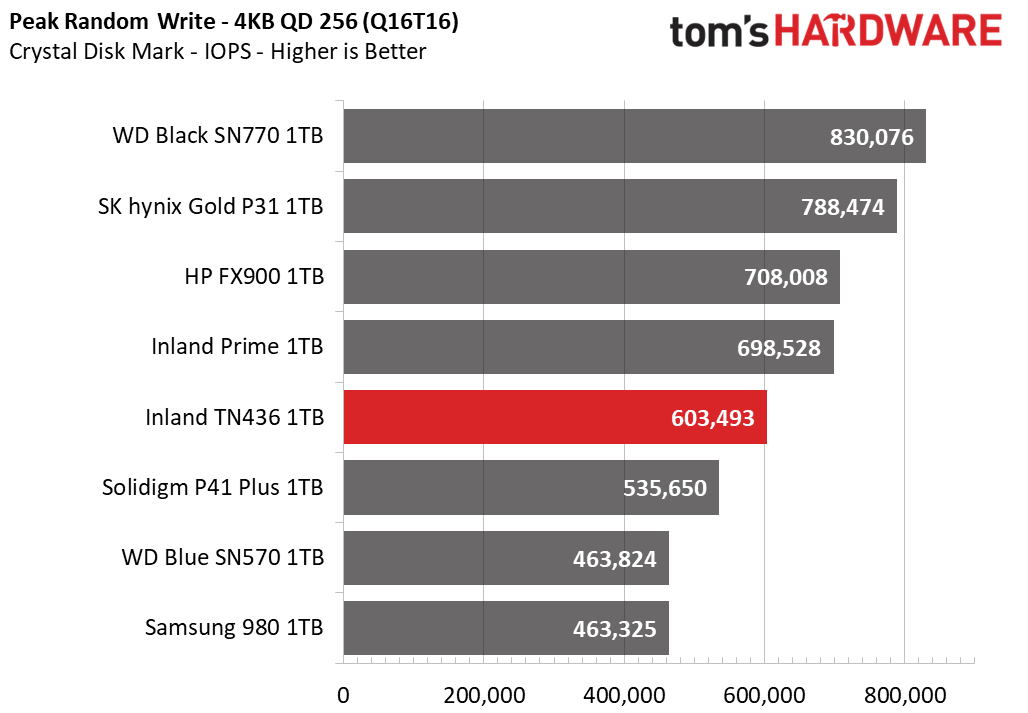
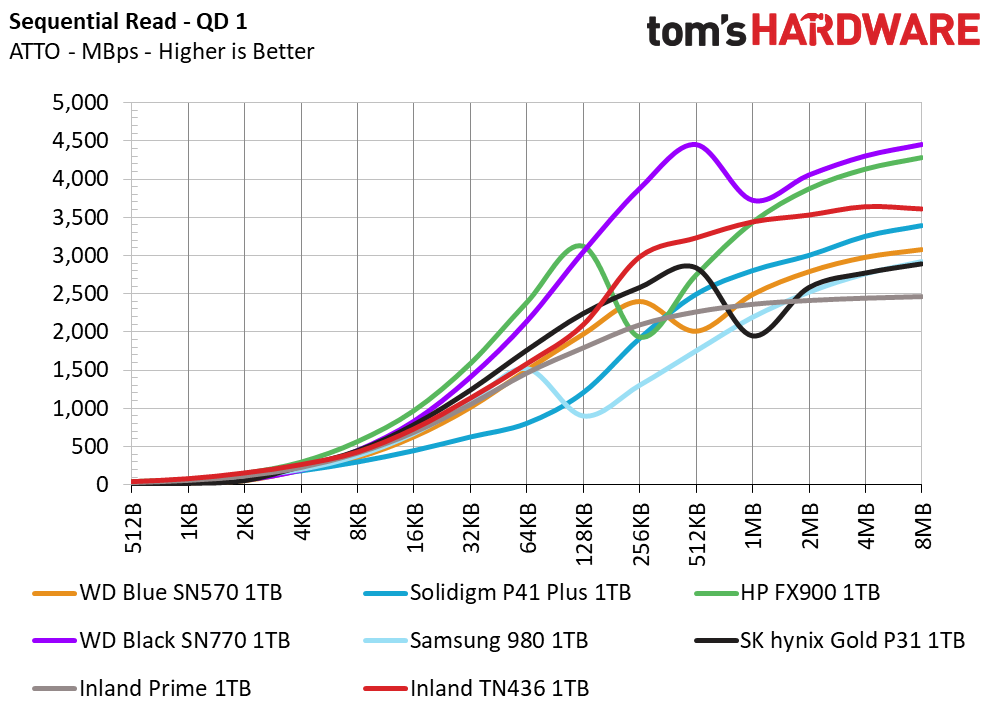
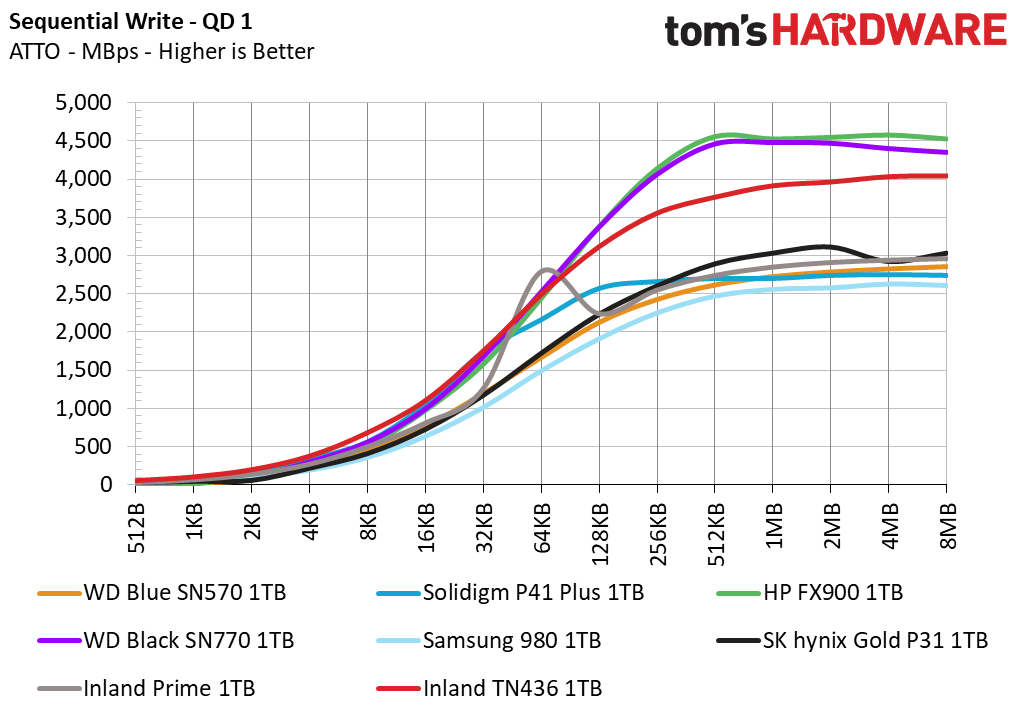
The TN436 scores well in ATTO, which is not surprising as Phison controllers tend to do well there. Sequential performance in CDM is not nearly as good. Although this is labeled as a PCIe 4.0 drive, there’s no real benefit from running it in a 4.0 slot. Random 4K results in CDM are also pretty poor on the whole. It’s clear that this is a drive designed for one purpose and that performance is a secondary priority.
It’s worth pointing out that the Prime, which is using Micron’s 176-layer TLC with a similar controller, is significantly faster with 4K random reads at queue depth 1. This result often correlates to “real world” feel and suggests an update to this flash with the E21T or comparable controller would likely provide a smoother experience.
Sustained Write Performance and Cache Recovery
Official write specifications are only part of the performance picture. Most SSDs implement a write cache, which is a fast area of (usually) pseudo-SLC programmed flash that absorbs incoming data. Sustained write speeds can suffer tremendously once the workload spills outside of the cache and into the "native" TLC or QLC flash. We use Iometer to hammer the SSD with sequential writes for 15 minutes to measure both the size of the write cache and performance after the cache is saturated. We also monitor cache recovery via multiple idle rounds.

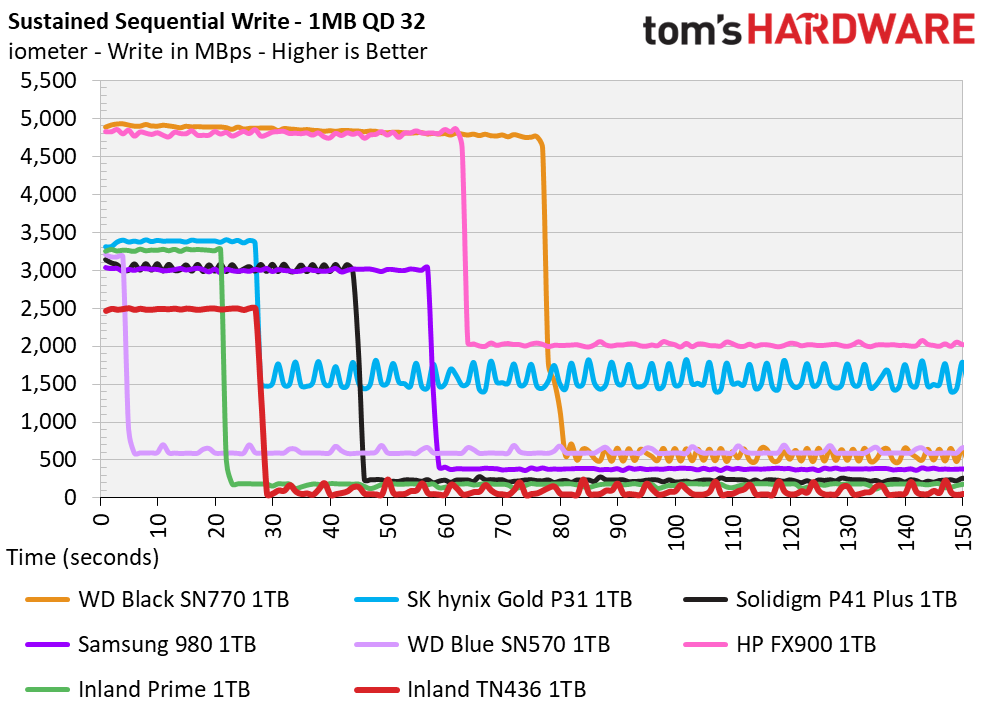
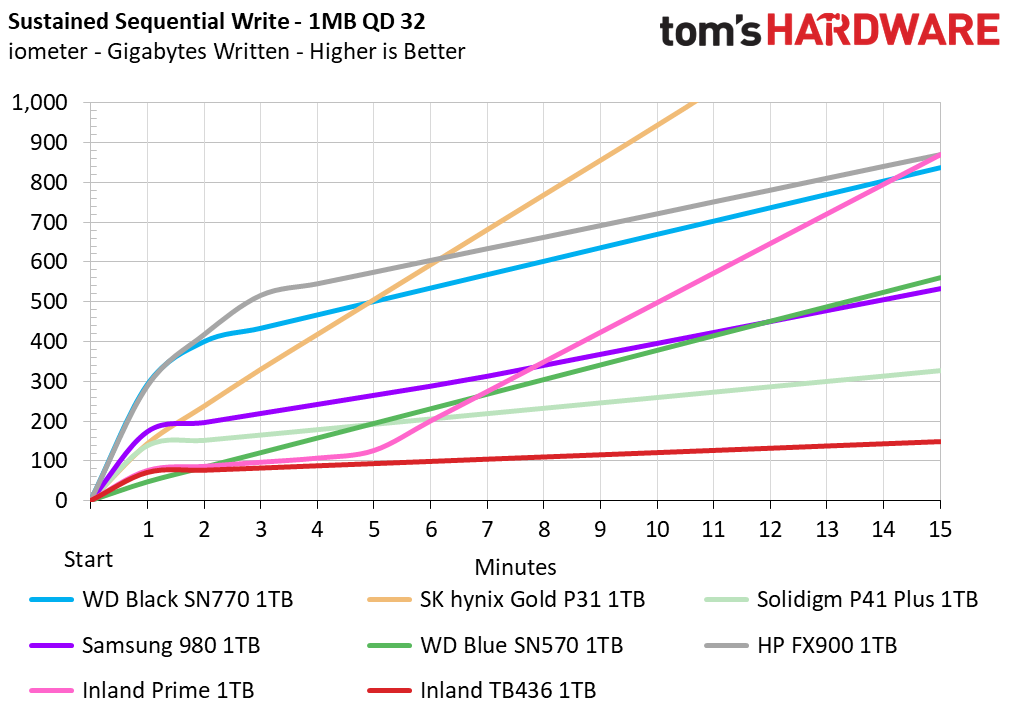

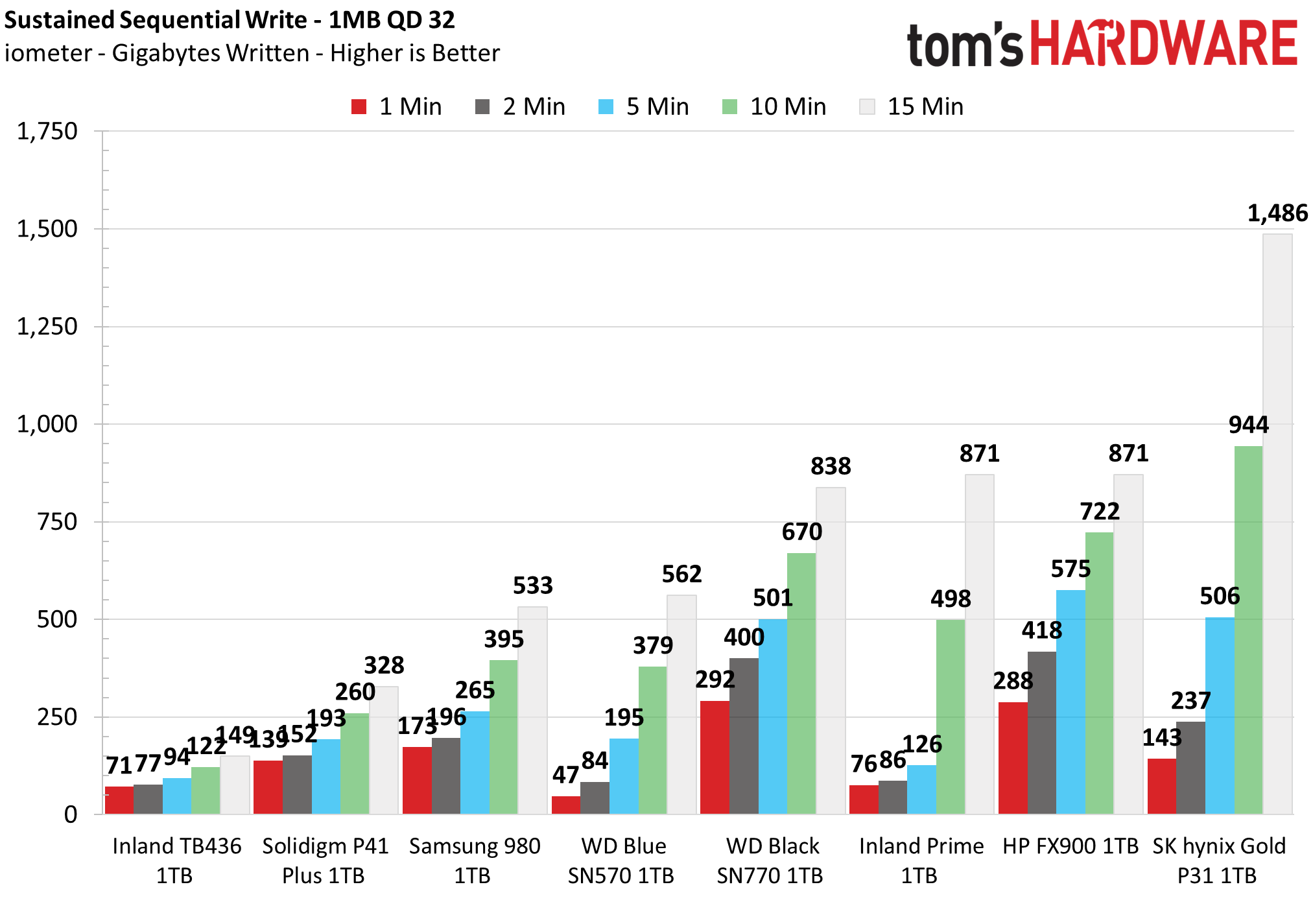
The 1TB TN436 writes at almost 2.5 GBps in pSLC mode for over 26 seconds for a cache of around 65GB. The drive then hits a deplorable folding state with write performance below 100 MBps. Performance is also inconsistent in that state, implying this drive would be particularly bad in edge cases, which includes fuller states. While the cache is small enough to recover with idle time, performance is generally bad enough to be concerning.
One limitation of 2230 drives is maximum capacity, and one nice thing about the TN436 is that it is 1TB. However, if performance is liable to tank with a fuller drive then that advantage is less attractive.
Power Consumption and Temperature
We use the Quarch HD Programmable Power Module to gain a deeper understanding of power characteristics. Idle power consumption is an important aspect to consider, especially if you're looking for a laptop upgrade as even the best ultrabooks can have mediocre storage.
Some SSDs can consume watts of power at idle while better-suited ones sip just milliwatts. Average workload power consumption and max consumption are two other aspects of power consumption, but performance-per-watt is more important. A drive might consume more power during any given workload, but accomplishing a task faster allows the drive to drop into an idle state more quickly, ultimately saving energy.
Temperatures are gauged at both idle and load states via sensor and an infrared thermometer. The typical ambient temperature is at 24C. The load state involves sustained writes at maximum speed with measurement ensuing if and until throttling is demonstrated to discover the equilibrium temperature.

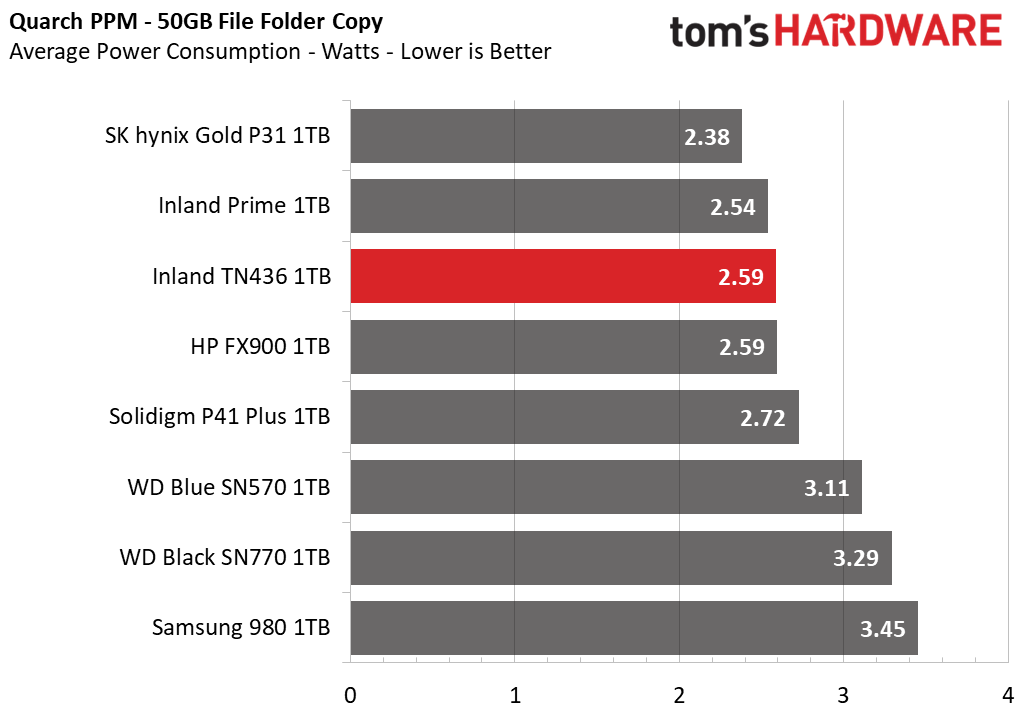


A drive used in a device like the Steam Deck needs to be power-efficient. When replacing the native drive, there are concerns about power draw and also thermal performance which can impact the performance and battery life of the host device.
The TN436 does okay, falling somewhere in the middle. The efficiency is generally good enough for its intended application. The numbers we’ve seen from the E21T and Micron’s 176-layer TLC suggest that future 2230 drives may be significantly superior, however, and with the relatively short battery life of the Steam Deck every bit matters. Of course, typical gaming scenarios will only have bursty moments of reads, so the overall impact would likely be higher with prosumer tasks on the Surface or on laptops.
We expect a drive like this to run hot, and it did. In a Steam Deck during typical use, however, it will mostly see bursty reads. Temperature is not the same as total heat dissipation, either. The drive may therefore not add a considerable amount of stress to your Deck hardware, but it’s still worth pointing out these results as we feel different hardware could make for a more efficient drive. The TN436 idled at 52C and hit 80C under load, although it did not seem to throttle. The write performance is just really slow once the pSLC cache is exhausted.
Test Bench and Testing Notes
| CPU | Intel Core i9-12900K |
| Motherboard | ASUS ROG Maximus Z690 Formula |
| Memory | 2x16GB Corsair Dominator DDR5 5600 CL36 |
| Graphics | Intel Iris Xe UHD Graphics 770 |
| CPU Cooling | Arctic Liquid Freezer II - 420 |
| Case | Streacom BC1 Open Benchtable |
| Power Supply | Corsair SF750 Platinum |
| OS Storage | Sabrent Rocket 4 Plus 2TB |
| Operating System | Windows 11 Pro |
We use an Alder Lake platform with most background applications such as indexing, Windows updates and anti-virus disabled in the OS to reduce run-to-run variability. Each SSD is prefilled to 50% capacity and tested as a secondary device. Unless noted, we use active cooling for all SSDs.
Conclusion
The Inland TN436 is designed to fill a niche, being a 1TB retail 2230 drive with a decent warranty that can fit into a lot of portable devices. The price tag reflects this specialization, even if it will work in many regular PCs. It’s certainly a better option than taking a risk with an OEM drive if this is your first rodeo, although if you are willing to go to the trouble to unofficially update your devices you are probably already willing to accept some risk. The TN436 appears to be based on an OEM drive so it is at least a safe bet to work pretty well in terms of compatibility.
However, the drive leaves a lot to be desired. Performance is weak all around and sustained performance is surprisingly bad. Power efficiency and heat generation are sufficient, but could be better. Hopefully some better retail alternatives will appear in the market to displace it as there is room for a product like this even with the price premium. Given all these factors the TN436 is difficult for us to recommend except for specific use cases, although that’s probably good enough for your Steam Deck.
MORE: Best SSDs
MORE: Best External SSDs and Hard Drives
MORE: How We Test HDDs And SSDs
MORE: All SSD Content

Shane Downing is a Freelance Reviewer for Tom’s Hardware US, covering consumer storage hardware.
-
petllama Are any of the comparison products even 2230? Why was the sn530 left out since it's one of the few 2230 1tb drives that comes highly recommended for the steam deck, which this product is advertising for.Reply -
patrick47018 This review really needs to be updated with testing showing performance vs. other 2230 drives.Reply -
watzupken Personally, I feel the performance of such small NVME SSDs are within my expectations. Given that this is a 2230, it will run into thermal throttling before it can hit anywhere near the PCI-E 4.0 transfer rate. My experience with a Samsung NVME 512GB drive in the 2242 form was that it ran so hot, it thermal throttled within a few seconds without any heatsink on it. And that was a PCI-E 3.0 drive. Even with a tall ram sink on it, the ram sink became so hot that I cannot even leave my finger on it for more than a second. So I expect 2230 to be worst since the heat concentration will be higher.Reply -
seanwebster Reply
As much as we would like to include more 2230 drives, there aren't many available in retail atm. Most are used, second-hand devices without any factory warranty. Unfortunately, the SN530 isn't a retail drive and it wasn't sampled to us for review, so we don't have a sample to compare to on hand. However, we recently sampled a Sabrent Rocket 2230 and will be able to compare it head-to-head in an upcoming review soon.petllama said:Are any of the comparison products even 2230? Why was the sn530 left out since it's one of the few 2230 1tb drives that comes highly recommended for the steam deck, which this product is advertising for.
Bear in mind, surfaces 50-55C+ are too hot to touch for us, but perfectly fine for these chips to operate at. Often, NAND controllers can reach temps of 70-85C before throttling.watzupken said:Personally, I feel the performance of such small NVME SSDs are within my expectations. Given that this is a 2230, it will run into thermal throttling before it can hit anywhere near the PCI-E 4.0 transfer rate. My experience with a Samsung NVME 512GB drive in the 2242 form was that it ran so hot, it thermal throttled within a few seconds without any heatsink on it. And that was a PCI-E 3.0 drive. Even with a tall ram sink on it, the ram sink became so hot that I cannot even leave my finger on it for more than a second. So I expect 2230 to be worst since the heat concentration will be higher. -
t-dome ReplyThe TN436 appears to be a retail variant of the OEM Kioxia BG5 which uses relatively new hardware but nothing cutting-edge.
If the hardware is similar, then the firmware surely is not. The BG5 has different specs, and also benchmarks on the Deck show completely different results.
My BG5 1 TB has slower sequential reads, but faster writes. And the random reads are 50% higher than those of the TN436.
